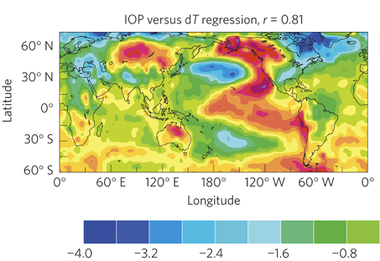UAlbany Study Explains Global Warming 'Hiatus' Since 2000
Inter-decadal Pacific Oscillation linked with essentially all the difference between observed and model-simulated global warming rates
ALBANY, N.Y. (April 14, 2015) -- Atmospheric greenhouse gases continue to rise during recent years, yet global-mean surface temperature has shown no clear warming since about year 2000. This slowdown in surface warming, often referred to as the global warming "hiatus," is in sharp contrast to model simulations, which on average show strong warming since 2000.
 |
|
Research suggests the Inter-decadal Pacific Oscillation is responsible for essentially all the difference between observed and model-simulated global warming rates on decadal time scales since 1920.
|
A new University at Albany study published in the April 13, 2015, issue of Nature Climate Change, links the Inter-decadal Pacific Oscillation (IPO) with essentially all the difference between observed and model-simulated global warming rates on decadal time scales since 1920, and in particular the warming hiatus since year 2000.
The study, led by Atmospheric and Environmental Sciences Associate Professor Aiguo Dai, includes co-authors, Dr. J. C. Fyfe of Environment Canada, Prof. Shang-ping Xie of UC, San Diego; and Dr. Xingang Dai of Institute of Atmpsoheric Physics/Chinese Academy of Sciences (IAP/CAS). Together the team analyzed, observed and model-simulated global temperature data and quantified the contributions of internal climate variability to decadal changes in global warming rate since 1920.
This large model-versus-observation discrepancy in global warming rate has attracted considerable attention in climate research and in news media, since it has the potential to undermine the credibility of climate models and their projected future climate changes.
"Naturally, people would ask the question: if the models cannot simulate the current global warming rate, how can we trust their projections of future climate change? This is a very reasonable question that deserves a satisfactory answer from the climate science community," said Dai. "The global warming hiatus has also been used to dismiss climate science entirely by some deniers of global warming. Thus, explaining the warming hiatus has become an urgent task for climate scientists."
Recent studies have attributed the warming hiatus to decadal cooling in the tropical Pacific, intensifying trade winds, changes in El Niño activity, increasing volcanic activity and decreasing solar irradiance that have not been adequately accounted for in model simulations. However, despite large efforts by many groups, a satisfactory explanation of the warming hiatus has remained elusive.
A key new aspect of this study was the use of the multi-model ensemble simulations to estimate the forced global warming and separate it from internal climate variations. Their analyses show that the Inter-decadal Pacific Oscillation, a prominent natural mode of multi-decadal variations in Pacific sea surface temperatures, has been associated with large temperature anomalies over both ocean and land.
Combined with another leading mode of internal climate variations, the IPO explains essentially all the difference between observed and model-simulated global warming rates on decadal time scales since 1920, and in particular the warming hiatus since year 2000. The spatial patterns of the IPO-induced temperature changes match observations but differ from those associated with GHG-induced warming or aerosol-induced cooling.
Dai and his co-authors conclude that internal climate variations, mainly through the IPO, were largely responsible for the recent slowdown, as well as for earlier slowdowns and accelerations in decadal global warming rates since 1920. "This finding is consistent with other recent studies and supports the notion that the recent warming hiatus resulted primarily from natural climate variations, rather than from aerosols or other causes missed by the models," said Dai.
Climate models still have difficulties in simulating observed IPO and other natural climate variations due to deficiencies in model physics and model starting conditions. Thus, discrepancies between observed and model-simulated global warming rates on decadal time scales should be expected, rather than taken as surprises.
"The model-versus-observation discrepancies do not imply that the model-simulated climate change due to rising greenhouse gases and other anthropogenic forcing is wrong," said Dai. "Recent history suggests that the IPO could reverse course soon. Should that happen, we may see accelerated global warming rates in the coming decades."
![]() For more news, subscribe to UAlbany's RSS headline feeds
For more news, subscribe to UAlbany's RSS headline feeds
A comprehensive public research university, the University at Albany-SUNY offers more than 120 undergraduate majors and minors and 125 master's, doctoral and graduate certificate programs. UAlbany is a leader among all New York State colleges and universities in such diverse fields as atmospheric and environmental sciences, business, education, public health,health sciences, criminal justice, emergency preparedness, engineering and applied sciences, informatics, public administration, social welfare and sociology, taught by an extensive roster of faculty experts. It also offers expanded academic and research opportunities for students through an affiliation with Albany Law School. With a curriculum enhanced by 600 study-abroad opportunities, UAlbany launches great careers.


